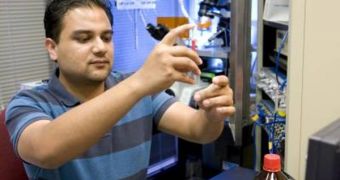In a new scientific study, researchers at the Salk Institute for Biological Studies have offered a new manner of looking at the way alcohol influences brain cells, at a level never before observed. The molecular actions of the active ingredients in alcohol on neurons have been sparsely studied, mostly because all research efforts have been orientated towards discovering the effects that consuming the stuff has on the human brain as a whole.
The new paper, which is published ahead of print, in the advanced online issue of the journal Nature Neuroscience, also shows that the new understanding of alcohol action could lead to the development of therapies against epilepsy, drug addiction and, naturally, alcoholism.
According to the research team, the alcohol trigger site they've studied is located physically within an ion channel protein. It has been known for quite some time that connections between neurons are adversely affected by consuming ethanol, the active ingredient inside commercially available alcoholic beverages.
“There's been a lot of interest in the field to find out how alcohol acts in the brain. One of several views held that ethanol works by interacting directly with ion channel proteins, but there were no studies that visualized the site of association,” the leader of the new study, Salk Institute Peptide Biology Laboratory Associate Professor Paul A. Slesinger, PhD, says.
The team now show in their research that ethanol interacts with a nook contained within a channel protein, and also that this ion channel plays a very important part in certain brain reactions to conditions such as drug addiction and epilepsy seizures. These GIRK channels (G-protein-activated inwardly rectifying potassium channels) have the ability to seriously damage the chemical signals moving through neurons, as they open up during signal transmission, and dampen it.
“When GIRK open in response to neurotransmitter activation, potassium ions leak out of the neuron, decreasing neuronal activity,” University of California in San Diego (UCSD) biology graduate student Prafulla Aryal, also the first author of the paper, explains.
Because they now have the exact location of the channel responsible for the effects of alcohol on the human brain, researchers are hopeful that they will soon be able to develop molecules that would counter-act the effect that ethanol has on the channels, thus making it easier for addicts to quit the habit. “If we could find a novel drug that fits the alcohol-binding site and then activate GIRK channels, this would dampen overall neuronal excitability in the brain and perhaps provide a new tool for treating epilepsy,” Slesinger adds.

 14 DAY TRIAL //
14 DAY TRIAL //